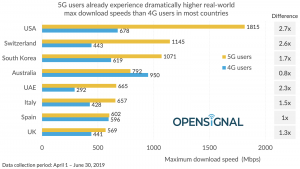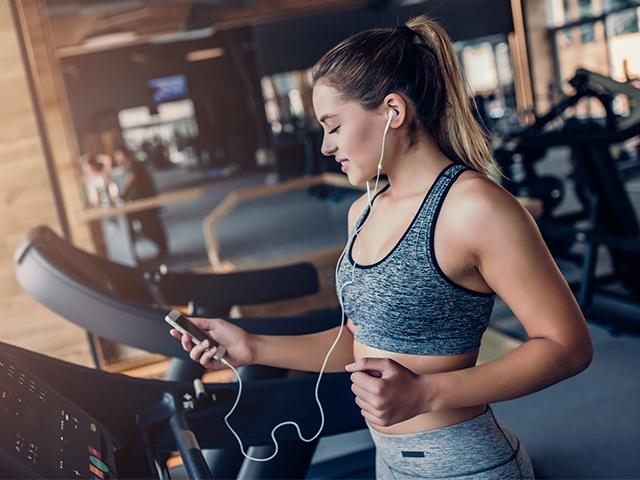Although the UK’s mobile operators are launching 5G cellular networks, coverage issues, particularly indoors, are causing gym users to stop exercising, writes George Malim.
With Vodafone and EE having launched 5G, the hype suggests stories of coverage woes are set to end. 5G is perceived to address the indoor coverage weaknesses of 4G and is also expected to bring radically increased coverage and capacity benefits. 5G is routinely said to offer speeds 100 times faster than 4G. However, network topology, the pace of roll-out and the availability of 5G-capable devices will not see this uplift arrive any time soon.
In fact, data from OpenSignal reveals that the current actual maximum download speed provided by 5G in the US is 2.7 times that of 4G. In the UK, where 5G networks are less well established, the figure is worse with 5G providing just 1.3 times the maximum download speed of 4G.
 In fairness, it is extremely early days for the technology and its deployment and initial roll-out will focus on densely populated areas with 5G equipment being installed at the same outdoor sites as 4G. This simply replicates many of the problems of obtaining 4G coverage indoors.
In fairness, it is extremely early days for the technology and its deployment and initial roll-out will focus on densely populated areas with 5G equipment being installed at the same outdoor sites as 4G. This simply replicates many of the problems of obtaining 4G coverage indoors.
A new study from GWS has highlighted a particular group of users that suffers from indoor coverage inadequacy – gym users. The study found that one in five gym users has stopped exercising to try and resolve issues with connectivity – at least, that’s their excuse.
The study reveals that network coverage is especially puffed out in gyms. Network coverage drops by nearly 20% when entering a gym and test conducted by GWS have found that network speeds are three times slower inside gyms than compared to outside when completing social media related tasks. In addition, testing fond that 8% of data tasks fail inside gyms. A typical photo upload takes nine seconds longer inside the gym than outside.
GWS’ team of engineers tested mobile network performance gathering nearly 13,000 task samples, covering both voice and data performance, inside and outside 30 of London’s top gyms including Pure Gym, Gymbox, Nuffield Health and Bannatyne Health Club.
Poor coverage is a significant problem for gym operators with 20% of Brits having felt forced to go outside to use their phones due to poor connectivity inside and a further 21% having stopped exercising to try and sort out their phone’s network problems while at the gym. 27% of gym-goers say that difficulties accessing the internet in the gym annoys them, with a further 19% claiming that they would switch gyms if theirs didn’t have a good mobile signal.
Wi-Fi woes
As gym users increasingly rely on their phones for entertainment while exercising plus apps that monitor their performance or enhance their routines, relying on Wi-Fi as users do at home looks to be a solution. However, Wi-Fi coverage in gyms is patchy and experiences are varied.
The survey found that 14% of consumers say that the very first thing they do when they get to a gym is search for the Wi-Fi network, but GWS’ engineers found that they couldn’t connect to the Wi-Fi in a number of the gyms they tested. Consumer polling results also mirror this as 17% say that they have not been able to get onto their gym’s Wi-Fi network. Once connected to the Wi-Fi network, GWS engineers discovered that download speeds are worse on average than on mobile, with speeds slowing by 32% for download tasks.
“Phone connectivity has become an integral part of our fitness routines – whether we’re using our phone to record progress via apps, post selfies to social media sites or stream music,” says Dr Paul Carter, the chief executive of GWS. “It’s interesting to note that mobile network speeds inside gyms are close if not better at times to Wi-Fi, but it still isn’t good enough if consumers are being forced to stop working out to check on connection issues.”
“Overall, while it’s exciting to see that mobile networks in the UK are deploying new technologies including 5G, there is still a lot of work that needs to be done to improve basic reliability indoors – particularly as our research shows that people opt for reliability over speed at a two to one ratio when choosing a mobile network,” adds Carter.
Provision of powerful indoor coverage looks to be a key differentiator for gym operators and, as richer media is utilised, gym users’ needs for low latency, high speed coverage will only increase. There is a substantial reality gap between the promises of 5G and the reality of the experience in gyms. At least for most gym users, I’m a swimmer and getting signal underwater poses an entirely different set of challenges.






